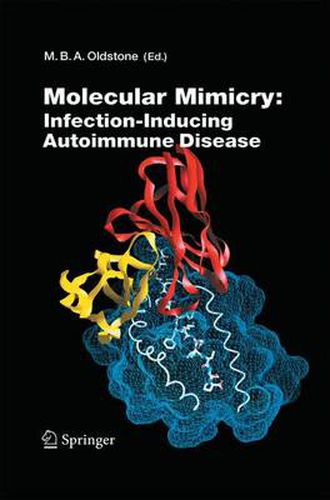Readings Newsletter
Become a Readings Member to make your shopping experience even easier.
Sign in or sign up for free!
You’re not far away from qualifying for FREE standard shipping within Australia
You’ve qualified for FREE standard shipping within Australia
The cart is loading…






This title is printed to order. This book may have been self-published. If so, we cannot guarantee the quality of the content. In the main most books will have gone through the editing process however some may not. We therefore suggest that you be aware of this before ordering this book. If in doubt check either the author or publisher’s details as we are unable to accept any returns unless they are faulty. Please contact us if you have any questions.
The purpose of this review is to examine the potential role of molecular mimicry in the pathogenesis of human T-lymphotropic virus type 1 ((HTLV- 1)-associated myelopathy/tropical spastic paraparesis (HAM/TSP)). Comp- hensive reviews on the pathogenic mechanisms of HTLV-1-associated human diseases are available throughout the medical literature (Bangham 2000,, 2003; Barmak et al. 2003; Jacobson 2002; Levin and Jacobson 1997; Nagai and Osame 2003; Osame 2002). Approximately 25 years ago the ?rst human retrovirus, HTLV-1, was isolated (Poeisz et al. 1980). Subsequently, infection with HTLV-1 was shown to cause adult T-cell leukemia (ATL) and HAM/TSP (Gessain et al. 1985; McFarlin and Blattner 1991; Osame et al. 1986; Poeisz et al. 1980; Yoshida et al. 1987). HTLV-1 may infect up to 30% of people in endemic areas and 10-20 million people worldwide (Barmak et al. 2003; Edlich et al. 2000). However, only 1%-5% develop either ATL or HAM/TSP, the remainder being clinically asymptomatic carriers of HTLV-1 (Bangham 2000, 2003; Barmak et al. 2003; Jacobson 2002; Levin and Jacobson 1997; Nagai and Osame 2003; Osame 2002). Why infection with HTLV-1 causes ATL or HAM/TSP in some people while the vast majority of individuals are asymptomatic is largely - known. Some possible factors that may differentiate the asymptomatic from the diseased state include viral strain, human histocompatibility leukocyte antigen (HLA), viral load, and the immune response (Bangham 2000, 2003; Barmak et al. 2003; Jacobson 2002; Levin and Jacobson 1997; Nagai and Osame 2003; Nagai et al. 1998; Niewiesk et al. 1994; Osame 2002).
$9.00 standard shipping within Australia
FREE standard shipping within Australia for orders over $100.00
Express & International shipping calculated at checkout
This title is printed to order. This book may have been self-published. If so, we cannot guarantee the quality of the content. In the main most books will have gone through the editing process however some may not. We therefore suggest that you be aware of this before ordering this book. If in doubt check either the author or publisher’s details as we are unable to accept any returns unless they are faulty. Please contact us if you have any questions.
The purpose of this review is to examine the potential role of molecular mimicry in the pathogenesis of human T-lymphotropic virus type 1 ((HTLV- 1)-associated myelopathy/tropical spastic paraparesis (HAM/TSP)). Comp- hensive reviews on the pathogenic mechanisms of HTLV-1-associated human diseases are available throughout the medical literature (Bangham 2000,, 2003; Barmak et al. 2003; Jacobson 2002; Levin and Jacobson 1997; Nagai and Osame 2003; Osame 2002). Approximately 25 years ago the ?rst human retrovirus, HTLV-1, was isolated (Poeisz et al. 1980). Subsequently, infection with HTLV-1 was shown to cause adult T-cell leukemia (ATL) and HAM/TSP (Gessain et al. 1985; McFarlin and Blattner 1991; Osame et al. 1986; Poeisz et al. 1980; Yoshida et al. 1987). HTLV-1 may infect up to 30% of people in endemic areas and 10-20 million people worldwide (Barmak et al. 2003; Edlich et al. 2000). However, only 1%-5% develop either ATL or HAM/TSP, the remainder being clinically asymptomatic carriers of HTLV-1 (Bangham 2000, 2003; Barmak et al. 2003; Jacobson 2002; Levin and Jacobson 1997; Nagai and Osame 2003; Osame 2002). Why infection with HTLV-1 causes ATL or HAM/TSP in some people while the vast majority of individuals are asymptomatic is largely - known. Some possible factors that may differentiate the asymptomatic from the diseased state include viral strain, human histocompatibility leukocyte antigen (HLA), viral load, and the immune response (Bangham 2000, 2003; Barmak et al. 2003; Jacobson 2002; Levin and Jacobson 1997; Nagai and Osame 2003; Nagai et al. 1998; Niewiesk et al. 1994; Osame 2002).